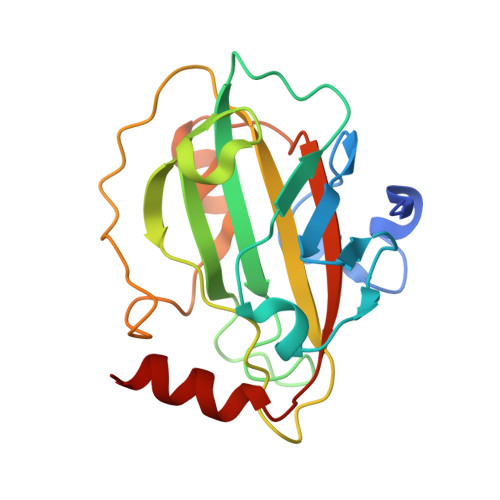Conserved salt-bridge competition triggered by phosphorylation regulates the protein interactome.
Skinner, J.J., Wang, S., Lee, J., Ong, C., Sommese, R., Sivaramakrishnan, S., Koelmel, W., Hirschbeck, M., Schindelin, H., Kisker, C., Lorenz, K., Sosnick, T.R., Rosner, M.R.(2017) Proc Natl Acad Sci U S A 114: 13453-13458
- PubMed: 29208709
- DOI: https://doi.org/10.1073/pnas.1711543114
- Primary Citation of Related Structures:
6ENS, 6ENT - PubMed Abstract:
Phosphorylation is a major regulator of protein interactions; however, the mechanisms by which regulation occurs are not well understood. Here we identify a salt-bridge competition or "theft" mechanism that enables a phospho-triggered swap of protein partners by Raf Kinase Inhibitory Protein (RKIP). RKIP transitions from inhibiting Raf-1 to inhibiting G-protein-coupled receptor kinase 2 upon phosphorylation, thereby bridging MAP kinase and G-Protein-Coupled Receptor signaling. NMR and crystallography indicate that a phosphoserine, but not a phosphomimetic, competes for a lysine from a preexisting salt bridge, initiating a partial unfolding event and promoting new protein interactions. Structural elements underlying the theft occurred early in evolution and are found in 10% of homo-oligomers and 30% of hetero-oligomers including Bax, Troponin C, and Early Endosome Antigen 1. In contrast to a direct recognition of phosphorylated residues by binding partners, the salt-bridge theft mechanism represents a facile strategy for promoting or disrupting protein interactions using solvent-accessible residues, and it can provide additional specificity at protein interfaces through local unfolding or conformational change.
- Ben May Department for Cancer Research, University of Chicago, Chicago, IL 60637.
Organizational Affiliation:


















